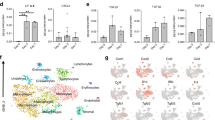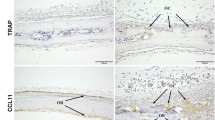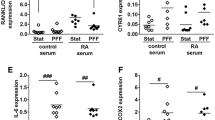Abstract
Monocyte chemotactic protein-1 (MCP-1) belongs to the CC chemokine superfamily and plays a critical role in the recruitment and activation of leukocytes during acute inflammation. We hypothesize that MCP-1 is also an important chemokine that regulates the recruitment and activation of bone cells required for skeletal repair and remodeling. We used the ulnar stress fracture (SFx) model, which allows investigation of focal remodeling with a known time course and precise anatomical location. SFx were created in the right ulna of female Wistar rats using cyclic end loading. Unloaded animals were used as a control. Rats were killed 4 h and 1, 4, 7, and 14 days after loading (n = 10/group); RNA was extracted and converted to cDNA for quantitative PCR analysis using TaqMan gene expression assays. Four hours after loading, MCP-1 gene expression was increased ~30-fold (P < 0.001), remained elevated at 24 h (~12-fold, P < 0.001), then declined by day 14. Relative to the contralateral limb, expression of the receptors CCR1 and CCR2 increased over the 14 days, being significant by 4 days for CCR1 and 14 days for CCR2 (P < 0.05). Other inflammation-related chemokines (RANTES, MIP1a) were not increased at these early time points. Using in situ hybridization and immunohistochemistry in separate animal groups (n = 5/group, control, days 1, 4, 7), MCP-1 mRNA and protein were localized in periosteal osteoblasts associated with woven bone formation at the fracture exit point but not in osteocytes adjacent to the SFx. These data support an important role for MCP-1 in the early phase of SFx repair and activated remodeling.




Similar content being viewed by others
References
Kidd LJ, Stephens AS, Kuliwaba JS, Fazzalari NL, Wu AC, Forwood MR (2010) Temporal pattern of gene expression and histology of stress fracture healing. Bone 46(2):369–378
Ley K (2003) Arrest chemokines. Microcirculation 10(3–4):289–295
Moser B, Willimann K (2004) Chemokines: role in inflammation and immune surveillance. Ann Rheum Dis 63(Suppl 2):ii84–ii89
Lisignoli G, Piacentini A, Cristino S, Grassi F, Cavallo C, Cattini L, Tonnarelli B, Manferdini C, Facchini A (2007) CCL20 chemokine induces both osteoblast proliferation and osteoclast differentiation: increased levels of CCL20 are expressed in subchondral bone tissue of rheumatoid arthritis patients. J Cell Physiol 210(3):798–806
McKenzie JA, Bixby EC, Silva MJ (2011) Differential gene expression from microarray analysis distinguishes woven and lamellar bone formation in the rat ulna following mechanical loading. PLoS One 6(12):e29328
Zannettino AC, Farrugia AN, Kortesidis A, Manavis J, To LB, Martin SK, Diamond P, Tamamura H, Lapidot T, Fujii N, Gronthos S (2005) Elevated serum levels of stromal-derived factor-1alpha are associated with increased osteoclast activity and osteolytic bone disease in multiple myeloma patients. Cancer Res 65(5):1700–1709
Choi SJ, Cruz JC, Craig F, Chung H, Devlin RD, Roodman GD, Alsina M (2000) Macrophage inflammatory protein 1-alpha is a potential osteoclast stimulatory factor in multiple myeloma. Blood 96(2):671–675
Han JH, Choi SJ, Kurihara N, Koide M, Oba Y, Roodman GD (2001) Macrophage inflammatory protein-1alpha is an osteoclastogenic factor in myeloma that is independent of receptor activator of nuclear factor kappaB ligand. Blood 97(11):3349–3353
Fuller K, Owens JM, Chambers TJ (1995) Macrophage inflammatory protein-1 alpha and IL-8 stimulate the motility but suppress the resorption of isolated rat osteoclasts. J Immunol 154(11):6065–6072
Yano S, Mentaverri R, Kanuparthi D, Bandyopadhyay S, Rivera A, Brown EM, Chattopadhyay N (2005) Functional expression of beta-chemokine receptors in osteoblasts: role of regulated upon activation, normal T cell expressed and secreted (RANTES) in osteoblasts and regulation of its secretion by osteoblasts and osteoclasts. Endocrinology 146(5):2324–2335
Moreaux J, Hose D, Kassambara A, Reme T, Moine P, Requirand G, Goldschmidt H, Klein B (2011) Osteoclast-gene expression profiling reveals osteoclast-derived CCR2 chemokines promoting myeloma cell migration. Blood 117(4):1280–1290
Palmqvist P, Persson E, Conaway HH, Lerner UH (2002) IL-6, leukemia inhibitory factor, and oncostatin M stimulate bone resorption and regulate the expression of receptor activator of NF-kappa B ligand, osteoprotegerin, and receptor activator of NF-kappa B in mouse calvariae. J Immunol 169(6):3353–3362
Tangirala RK, Murao K, Quehenberger O (1997) Regulation of expression of the human monocyte chemotactic protein-1 receptor (hCCR2) by cytokines. J Biol Chem 272(12):8050–8056
Wise GE, Frazier-Bowers S, D’Souza RN (2002) Cellular, molecular, and genetic determinants of tooth eruption. Crit Rev Oral Biol Med 13(4):323–334
Kim MS, Day CJ, Morrison NA (2005) MCP-1 is induced by receptor activator of nuclear factor-κB ligand, promotes human osteoclast fusion, and rescues granulocyte macrophage colony-stimulating factor suppression of osteoclast formation. J Biol Chem 280(16):16163–16169
Li X, Liu H, Qin L, Tamasi J, Bergenstock M, Shapses S, Feyen JH, Notterman DA, Partridge NC (2007) Determination of dual effects of parathyroid hormone on skeletal gene expression in vivo by microarray and network analysis. J Biol Chem 282(45):33086–33097
Richards CD, Langdon C, Deschamps P, Pennica D, Shaughnessy SG (2000) Stimulation of osteoclast differentiation in vitro by mouse oncostatin M, leukaemia inhibitory factor, cardiotrophin-1 and interleukin 6: synergy with dexamethasone. Cytokine 12(6):613–621
Walker EC, McGregor NE, Poulton IJ, Solano M, Pompolo S, Fernandes TJ, Constable MJ, Nicholson GC, Zhang JG, Nicola NA, Gillespie MT, Martin TJ, Sims NA (2010) Oncostatin M promotes bone formation independently of resorption when signaling through leukemia inhibitory factor receptor in mice. J Clin Invest 120(2):582–592
Kidd LJ, Cowling NR, Wu AC, Kelly WL, Forwood MR (2011) Bisphosphonate treatment delays stress fracture remodeling in the rat ulna. J Orthop Res 29(12):1827–1833
Lisignoli G, Toneguzzi S, Grassi F, Piacentini A, Tschon M, Cristino S, Gualtieri G, Facchini A (2002) Different chemokines are expressed in human arthritic bone biopsies: IFN-gamma and IL-6 differently modulate IL-8, MCP-1 and RANTES production by arthritic osteoblasts. Cytokine 20(5):231–238
Lisignoli G, Toneguzzi S, Pozzi C, Piacentini A, Grassi F, Ferruzzi A, Gualtieri G, Facchini A (1999) Chemokine expression by subchondral bone marrow stromal cells isolated from osteoarthritis (OA) and rheumatoid arthritis (RA) patients. Clin Exp Immunol 116(2):371–378
Sims NA, Walsh NC (2010) GP130 cytokines and bone remodelling in health and disease. BMB Rep 43(8):513–523
Somjen D, Binderman I, Berger E, Harell A (1980) Bone remodelling induced by physical stress is prostaglandin E2 mediated. Biochim Biophys Acta 627(1):91–100
Partridge NC, Kemp BE, Veroni MC, Martin TJ (1981) Activation of adenosine 3′,5′-monophosphate–dependent protein kinase in normal and malignant bone cells by parathyroid hormone, prostaglandin E2, and prostacyclin. Endocrinology 108(1):220–225
Okamatsu Y, Kim D, Battaglino R, Sasaki H, Spate U, Stashenko P (2004) MIP-1 gamma promotes receptor-activator-of-NF-kappa-B-ligand-induced osteoclast formation and survival. J Immunol 173(3):2084–2090
Onan D, Allan EH, Quinn JM, Gooi JH, Pompolo S, Sims NA, Gillespie MT, Martin TJ (2009) The chemokine Cxcl1 is a novel target gene of parathyroid hormone (PTH)/PTH-related protein in committed osteoblasts. Endocrinology 150(5):2244–2253
Wright LM, Maloney W, Yu X, Kindle L, Collin-Osdoby P, Osdoby P (2005) Stromal cell–derived factor-1 binding to its chemokine receptor CXCR4 on precursor cells promotes the chemotactic recruitment, development and survival of human osteoclasts. Bone 36(5):840–853
Kim MS, Magno CL, Day CJ, Morrison NA (2006) Induction of chemokines and chemokine receptors CCR2b and CCR4 in authentic human osteoclasts differentiated with RANKL and osteoclast like cells differentiated by MCP-1 and RANTES. J Cell Biochem 97(3):512–518
Mantila Roosa SM, Liu Y, Turner CH (2011) Gene expression patterns in bone following mechanical loading. J Bone Miner Res 26(1):100–112
Sample SJ, Collins RJ, Wilson AP, Racette MA, Behan M, Markel MD, Kalscheur VL, Hao Z, Muir P (2010) Systemic effects of ulna loading in male rats during functional adaptation. J Bone Miner Res 25(9):2016–2028
Jay PR, Centrella M, Lorenzo J, Bruce AG, Horowitz MC (1996) Oncostatin-M: a new bone active cytokine that activates osteoblasts and inhibits bone resorption. Endocrinology 137(4):1151–1158
Acknowledgments
This study was supported in part by National Health and Medical Research Council project grants (511187, 597481, and APP1049190), the Rebecca L. Cooper Medical Research Foundation, and a Griffith University New Staff Research Grant (to A. C. W.). Those funding agencies had no role in the study design; data collection, analysis, or interpretation; the writing of the report; or the decision to submit the article for publication. We thank Mr. Bradley Paterson for expert histotechnical assistance.
Author information
Authors and Affiliations
Corresponding author
Additional information
The authors have stated that they have no conflict of interest.
Rights and permissions
About this article
Cite this article
Wu, A.C., Morrison, N.A., Kelly, W.L. et al. MCP-1 Expression Is Specifically Regulated During Activation of Skeletal Repair and Remodeling. Calcif Tissue Int 92, 566–575 (2013). https://doi.org/10.1007/s00223-013-9718-6
Received:
Accepted:
Published:
Issue Date:
DOI: https://doi.org/10.1007/s00223-013-9718-6




